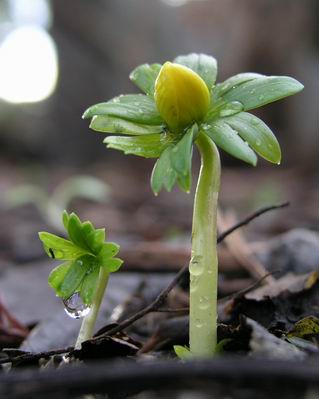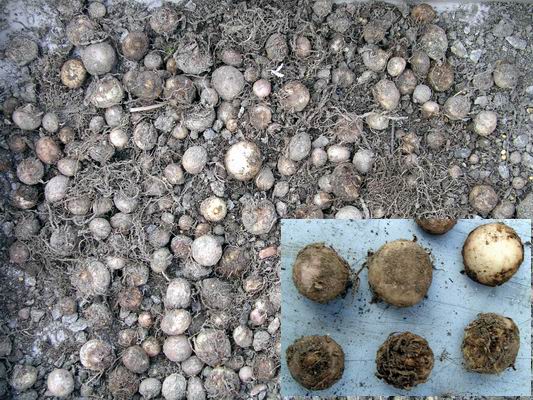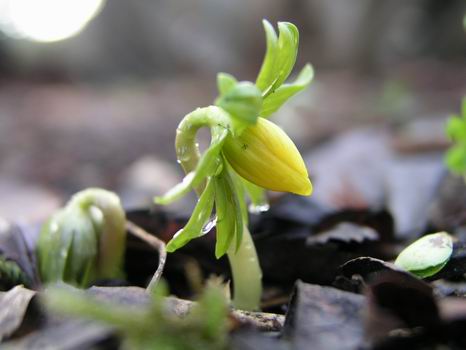 |
SRGC Bulb Log Diary |
| Home Recommend This Site To A Friend |
|
NUMBER 3 14th JANUARY 2004

Eranthis hyemalis 1. The very first of the Eranthis hyemalis has just pushed through the leaf litter in the garden and what a beautiful sight it is. I spied it while watching the garden birds through binoculars from the warmth of the kitchen. I have often been inspired to photograph a plant after viewing it through binoculars, they have a way of isolating the subject and giving you a different view point from the normal way you see it, this picture was taken with the camera flat to the ground. 
Crocus imperati suaveolens. Another crocus has been encouraged to open its flowers in the sunshine. Crocus imperati suaveolens has a not-very-attractive puce-coloured exterior, only saved by the dark stripes that line the outer three tepals, but, when it opens, it reveals a lovely pale violet interior. 
Crocus imperati suaveolens open. Lots of shoots are just starting to emerge in all the glass houses; like this Corydalis maracandica. 
Corydalis emerging. The shoots from this corm run sideways before they turn up towards the surface so when we grow them in a pot all the shoots appear around the rim of the pot. . I know that some people do not like this habit but there is no solution to this pattern of growth - like male baldness we have to accept it. Once the large grey-green leaves and yellow flowers emerge you will hardly be aware of this pattern of growth. 
Arisaema seed box. Other bulbs are still completely dormant, like this Arisaema. These are the contents of a fish box trough into which I sowed the seed some three or four years ago. It is now time to give them more space so I have been planting the larger ones around the garden while the smaller ones have been replanted back in the box in a fresh mix of compost to grow on for a further year or two. It is often difficult to tell which way up to plant Arisaemas so I have pasted the enlarged inset to show the bottom three are the correct way up , you can just make out the small shoot, and the top three are upside down. The two to the left have a very thin skin, which is the remains of last years bulb, still attached while the smooth round surface of the right hand one has had this skin removed. If at any time you are not sure which way up to plant a bulb then just plant it on its side and it will be fine. In fact it does not make that much difference if you plant a bulb upside down as it will still grow. 
Frit. stenanthera seedlings. This is the same pot of Fritillaria stenanthera seedlings, photographed over the last three weeks to show the rate of growth that the seedlings make. They were sown in October 2002 and germinated last year so this is their second year of growth, which, as you can see, has progressed from only just showing three weeks ago, to having quite well- developed leaves this week. 
Applying Sulphate of potash. I have now started to apply the sulphate of potash to the early flowering Narcissus as well as the autumn flowering Crocus and Cyclamen. 
Sulphate of potash. It is readily obtainable at garden centres in a white powder form and as you will see from the analysis I have pasted at the top, it is rich in potassium, just what the bulbs need to act as both a tonic and help build a strong bulb which can produce next years flowers. 
Potash A good spoonful is sprinkled onto the surface of each pot just before I water them. 
Narcissus romieuxii x2. Two more forms of Narcissus romieuxii are coming into flower now. On the left is the typical wide faced (petunioide) form raised from Jim Archibald's collection JCA805 which has produced so many outstanding forms since he introduced it many, many years ago. The right hand one is a form of N. romieuxii zianicus - it has a more funnel shaped yellow flower. I will leave you with another Eranthis hyemalis picture, the second of the only two to appear so far this year. This is another advantage to raising bulbs from seed, they will not all flower at the same time so increasing the flowering period. 
Eranthis hyemalis 2. ^ back to the top ^ |